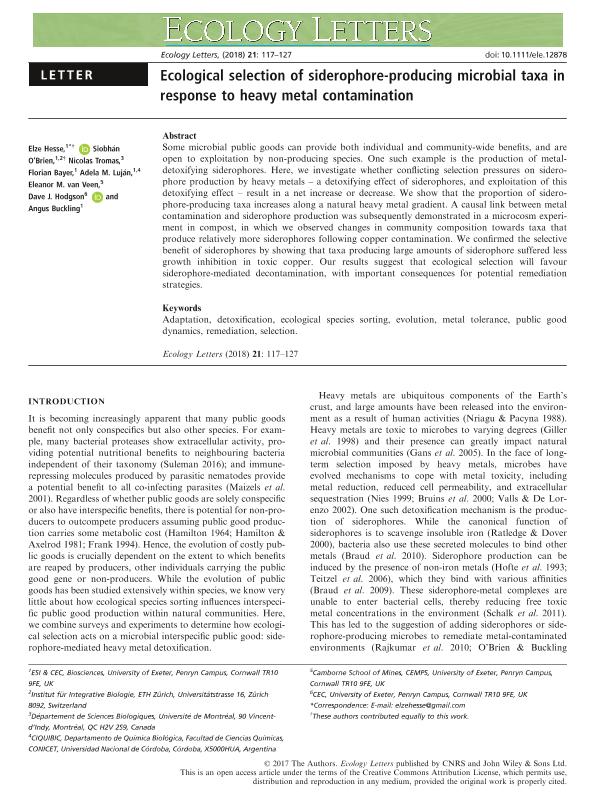Artículo
Ecological selection of siderophore-producing microbial taxa in response to heavy metal contamination
Hesse, Elze; O'Brien, Siobhán; Tromas, Nicolas; Bayer, Florian; Lujan, Adela Maria ; van Veen, Eleanor M.; Hodgson, Dave J.; Buckling, Angus
; van Veen, Eleanor M.; Hodgson, Dave J.; Buckling, Angus
 ; van Veen, Eleanor M.; Hodgson, Dave J.; Buckling, Angus
; van Veen, Eleanor M.; Hodgson, Dave J.; Buckling, Angus
Fecha de publicación:
01/2018
Editorial:
Wiley Blackwell Publishing, Inc
Revista:
Ecology Letters
ISSN:
1461-023X
Idioma:
Inglés
Tipo de recurso:
Artículo publicado
Clasificación temática:
Resumen
Some microbial public goods can provide both individual and community-wide benefits, and are open to exploitation by non-producing species. One such example is the production of metal-detoxifying siderophores. Here, we investigate whether conflicting selection pressures on siderophore production by heavy metals – a detoxifying effect of siderophores, and exploitation of this detoxifying effect – result in a net increase or decrease. We show that the proportion of siderophore-producing taxa increases along a natural heavy metal gradient. A causal link between metal contamination and siderophore production was subsequently demonstrated in a microcosm experiment in compost, in which we observed changes in community composition towards taxa that produce relatively more siderophores following copper contamination. We confirmed the selective benefit of siderophores by showing that taxa producing large amounts of siderophore suffered less growth inhibition in toxic copper. Our results suggest that ecological selection will favour siderophore-mediated decontamination, with important consequences for potential remediation strategies.
Archivos asociados
Licencia
Identificadores
Colecciones
Articulos(CIQUIBIC)
Articulos de CENTRO DE INVEST.EN QCA.BIOL.DE CORDOBA (P)
Articulos de CENTRO DE INVEST.EN QCA.BIOL.DE CORDOBA (P)
Citación
Hesse, Elze; O'Brien, Siobhán; Tromas, Nicolas; Bayer, Florian; Lujan, Adela Maria; et al.; Ecological selection of siderophore-producing microbial taxa in response to heavy metal contamination; Wiley Blackwell Publishing, Inc; Ecology Letters; 21; 1; 1-2018; 117-127
Compartir
Altmétricas



